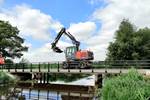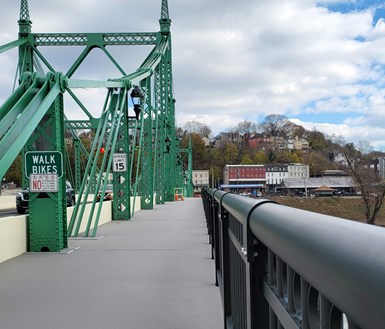CCG FRP panels rehabilitate historic Northamption Street Bridge
High-strength, composite molded, prefabricated panels solve weight problems for the heavily-trafficked bridge, providing cantilever sidewalks for wider shared use paths.
This spring, the Delaware River Joint Toll Bridge Commission (New Hope, Pa., U.S.) will complete a two-year rehabilitation project for Northampton Street Bridge. Located between Easton, Pennsylvania and Phillipsburg, New Jersey, the historic cantilever truss bridge is the only three-lane vehicular structure in the commission’s system and the most heavily traveled. A 2018 inspection revealed the need for overhaul with goals to extend the life of the 125-year-old “free bridge” and reduce maintenance. Creative Composites Group’s (CCG, Alum Bank, Pa., U.S.) fiber-reinforced polymer (FRP) composite molded panels were selected to replace the bridge’s aging sidewalks with wider yet lighter weight shared use paths.
“The infrastructure industry has adopted FRP as the go-to material for rehabilitation and repair of historic bridges due to their inherent weight restrictions,” says Scott Reeve, business development for CCG. “Concrete combined with current traffic loads is too heavy for a rare bridge design like Northampton. FRP panels are 80% lighter than reinforced concrete panels. The design flexibility of FRP allows us to produce a corrosion-resistant, prefabricated cantilever sidewalk that maintains the historic integrity and function of the bridge while extending its life and eliminating maintenance.”
CCG designed the new 10.5-foot-wide sidewalks to cantilever off the truss structure. Panel dimensions were based on supports with a stringer span of 42 inches. The 25-foot-long panels, at sloped thicknesses of 2.875 inches to 4.125 inches, were built to AASHTO H-5 standards for a uniform pedestrian live load of 90 psf and a 10,000-pound service vehicle load. Pedestrian mid-span deflection was limited to L/500 and vehicle mid-span deflection was limited to L/300. Other parameters included wind uplift loading of 30 psf and an operating temperature range between -40°F and 160°F.
Materials for the FRP panels were sourced in the U.S. Produced at an ISO 9001:2015 compliant facility in Dayton, Ohio, the FRP molded panels were prefabricated to include cover plates at truss cutouts, expansion plates at span ends, molded openings for hatches and lamp post pedestals.
“We’re not taking pieces of fiberglass or plastic lumber and building a sidewalk on a work site,” says Reeve. “We made the decision more than a decade ago to deliver highly engineered, prefabricated products. We do this by spending more time upfront on design coordination with the contractor. The contractor surveys these older bridges and we use that data to provide a product that is dimensionally precise. Prefabrication drives faster installation which reduces the amount of time a bridge has to be closed to traffic. This approach also increases safety for commuters and construction workers. It takes more time during the design phase, but pays off during the construction phase with lower costs and a higher safety factor.”
CCG has also provided solutions for a Cleveland pedestrian drawbridge, and was sourced for five upcoming bridge rehabilitation projects in June 2022.
Related Content
-
SGL Carbon carbon fiber enables German road bridge milestone
A 64-meter road bridge installed with carbon fiber reinforcement is said to feature a first in modern European bridge construction, in addition to reducing construction costs and CO2 emissions.
-
Novel composite technology replaces welded joints in tubular structures
The Tree Composites TC-joint replaces traditional welding in jacket foundations for offshore wind turbine generator applications, advancing the world’s quest for fast, sustainable energy deployment.
-
Gatorbar, NEG, ExxonMobil join forces for composite rebar
ExxonMobil’s Materia Proxima polyolefin thermoset resin systems and glass fiber from NEG-US is used to produce GatorBar, an industry-leading, glass fiber-reinforced composite rebar (GFRP).
















